Studying the Indoor Environment and Comfort of a University Laboratory: Air-Conditioning Operation and Natural Ventilation Used as a Countermeasure against COVID-19
Abstract
:1. Introduction
2. Method
2.1. Overview of Measurement
2.2. Conditions of Measurement
3. Result
3.1. Measurement Results of Summer
3.1.1. Changes in Temperature and Humidity
3.1.2. Change in CO2 Concentration
3.1.3. Questionnaire Survey Results
3.2. Measurement Results during the Winter
3.2.1. Changes in Temperature and Humidity
3.2.2. Change in CO2 Concentration
3.2.3. Questionnaire Survey Results
3.3. Predicted Mean Vote (PMV)
4. Discussion
5. Conclusions
Author Contributions
Funding
Institutional Review Board Statement
Informed Consent Statement
Data Availability Statement
Acknowledgments
Conflicts of Interest
References
- SARS. Available online: https://www.who.int/health-topics/severe-acute-respiratory-syndrome#tab=tab_1 (accessed on 20 July 2020).
- Influenza A (H1N1). Available online: https://www.who.int/emergencies/situations/influenza-a-(h1n1)-outbreak (accessed on 22 July 2020).
- MERS. Available online: http://www.emro.who.int/health-topics/mers-cov/mers-outbreaks.html (accessed on 22 July 2020).
- COVID-19, WHO. Available online: https://covid19.who.int/ (accessed on 14 May 2022).
- Cabinet Secretariat, Japan. Countermeasures for COVID-19 Infection. Available online: https://corona.go.jp/emergency/ (accessed on 9 March 2021).
- Ministry of Health, Labour and Welfare. Countermeasures for COVID-19 Infection. Available online: https://www.mhlw.go.jp/stf/covid-19/kenkou-iryousoudan.html (accessed on 9 March 2021).
- Ministry of Health, Labour and Welfare. Ventilation Method for Improving Closed Space with Poor Ventilation. Available online: https://www.mhlw.go.jp/stf/newpage_15102.html (accessed on 9 March 2021).
- WHO. Coronavirus Disease (COVID-19): How Is It Transmitted? Available online: www.who.int/news-room/questions-andanswers/item/coronavirus-disease-covid-19-how-is-it-transmitted (accessed on 24 February 2022).
- ASHRAE. ASHRAE Position Document on Infectious Aerosols. Available online: http://www.ashrae.org/file%20library/about/position%20documents/pd_infectiousaerosols_2020.pdf (accessed on 24 February 2022).
- REHVA. REHVA COVID-19 Guidance. Available online: http://www.rehva.eu/fileadmin/user_upload/REHVA_COVID-19_guidance_document_ver2_20200403_1.pdf (accessed on 24 February 2022).
- Luo, M.; Cao, B.; Damiens, J.; Lin, B.; Zhu, Y. Evaluating thermal comfort in mixed-mode buildings: A field study in a subtropical climate. Build. Environ. 2015, 88, 46–54. [Google Scholar] [CrossRef]
- Hummelgaard, J.; Juhl, P.; Sæbjörnsson, K.; Clausen, G.; Toftum, J.; Langkilde, G. Indoor air quality and occupant satisfaction in five mechanically and four naturally ventilated open-plan office buildings. Build. Environ. 2007, 42, 4051–4058. [Google Scholar] [CrossRef]
- Cao, S.-J.; Ren, C. Ventilation control strategy using low-dimensional linear ventilation models and artificial neural network. Build. Environ. 2018, 144, 316–333. [Google Scholar] [CrossRef]
- Tanabe, S.-I.; Haneda, M.; Nishihara, N. Workplace productivity and individual thermal satisfaction. Build. Environ. 2015, 91, 42–50. [Google Scholar] [CrossRef]
- Yu, Z.; Fung, B.C.M.; Haghighat, F.; Yoshino, H.; Morofsky, E. A systematic procedure to study the influence of occupant behavior on building energy consumption. Energy Build. 2011, 43, 1409–1417. [Google Scholar] [CrossRef] [Green Version]
- Zhao, Q.; Lian, Z.; Lai, D. Thermal comfort models and their developments: A review. Energy Built Environ. 2021, 2, 21–33. [Google Scholar] [CrossRef]
- Indraganti, M.; Rao, K.D. Effect of age, gender, economic group and tenure on thermal comfort: A field study in residential buildings in hot and dry climate with seasonal variations. Energy Build. 2010, 42, 273–281. [Google Scholar] [CrossRef]
- Szekeres, S.; Kostyák, A.; Szodrai, F.; Csáky, I. Investigation of Ventilation Systems to Improve Air Quality in the Occupied Zone in Office Buildings. Buildings 2022, 12, 493. [Google Scholar] [CrossRef]
- Ortiz, M.A.; Kurvers, S.R.; Bluyssen, P.M. A review of comfort, health, and energy use: Understanding daily energy use and wellbeing for the development of a new approach to study comfort. Energy Build. 2017, 152, 323–335. [Google Scholar] [CrossRef]
- Rupp, R.F.; Vasquez, N.G.; Lamberts, R. A review of human thermal comfort in the built environment. Energy Build. 2015, 105, 178–205. [Google Scholar] [CrossRef]
- Schweiker, M.; Huebner, G.M.; Kingma, B.R.M.; Kramer, R.; Pallubinsky, H. Drivers of diversity in human thermal perception—A review for holistic comfort models. Temperature 2018, 5, 308–342. [Google Scholar] [CrossRef]
- Daisey, J.M.; Angell, W.J.; Apte, M.G. Indoor air quality, ventilation and health symptoms in schools: An analysis of existing information. Indoor Air 2003, 13, 53–64. [Google Scholar] [CrossRef] [PubMed]
- Hong, T.; Taylor-Lange, S.C.; D’Oca, S.; Yan, D.; Corgnati, S.P. Advances in research and applications of energy-related occupant behavior in buildings. Energy Build. 2016, 116, 694–702. [Google Scholar] [CrossRef] [Green Version]
- Stazi, F.; Naspi, F.; D’Orazio, M. A literature review on driving factors and contextual events influencing occupants’ behaviours in buildings. Build. Environ. 2017, 118, 40–66. [Google Scholar] [CrossRef]
- Van Den Wymelenberg, K. Patterns of occupant interaction with window blinds: A literature review. Energy Build. 2012, 51, 165–176. [Google Scholar] [CrossRef]
- Emmerich, S.J.; Dols, W.S.; Axley, J.W. Natural Ventilation Review and Plan for Design and Analysis Tools. National Institute of Standards and Technology: Gaithersburg, MD, USA, 2001. [Google Scholar]
- Yamanaka, T.; Kotani, H.; Iwamoto, K.; Kato, M. Natural, wind-forced ventilation caused by turbulence in a room with a single opening. Int. J. Vent. 2006, 5, 179–187. [Google Scholar] [CrossRef]
- Eftekhari, M.M.; Marjanovic, L.D.; Pinnock, D.J. Air flow distribution in and around a single-sided naturally ventilated room. Build. Environ. 2003, 38, 389–397. Available online: https://azure.microsoft.com/ja-jp/services/cognitive-services/face/#overview (accessed on 24 May 2020). [CrossRef]
- Yamamoto, Y.; Tanabe, S.-I. The criteria of outdoor conditions for operating natural ventilation openings. J. Environ. Eng. Transact. AIJ 2016, 81, 375–384. [Google Scholar]
- ISO 7730:2005; Ergonomics of the Thermal Environment—Analytical Determination and Interpretation of Thermal Comfort Using Calculation of the PMV and PPD Indices and Local Thermal Comfort Criteria. ASTM: West Conshohocken, PA, USA, 2005.
- ISO 10551:2019; Ergonomics of the Physical Environment—Subjective Judgement Scales for Assessing Physical Environments. ASTM: West Conshohocken, PA, USA, 2019.
- WHO. Modes of Transmission of Virus Causing COVID-19: Implications for IPC Precaution Recommendations, Scientific Brief. 29 March 2020. Available online: https://apps.who.int/iris/bitstream/handle/10665/331616/WHO-2019-nCoV-Sci_Brief-Transmission_modes-2020.2-eng.pdf?sequence=1&isAllowed=y (accessed on 24 February 2021).
- Wiersinga, W.J.; Rhodes, A.; Cheng, A.C.; Peacock, S.J.; Prescott, H.C. Pathophysiology, Transmission, Diagnosis, and Treatment of Coronavirus Disease 2019 (COVID-19), A review. JAMA 2020, 324, 782–793. [Google Scholar] [CrossRef]
- Johnson, G.R.; Morawska, L.; Ristovski, Z.D.; Hargreaves, M.; Mengersen, K.; Chao, C.Y.H.; Wan, M.P.; Li, Y.; Xie, X.; Katoshevski, D.; et al. Modality of human expired aerosol size distributions. J. Aerosol Sci. 2011, 42, 839–851. [Google Scholar] [CrossRef]
- Riederer, A.M.; Krenz, J.E.; Tchong-French, M.I.; Torres, E.; Perez, A.; Younglove, L.R.; Jansen, K.L.; Hardie, D.C.; Farquhar, S.A.; Sampson, P.D.; et al. Effectiveness of portable HEPA air cleaners on reducing indoor PM2.5 and NH3 in an agricultural cohort of children with asthma: A randomized intervention trial. Indoor Air. 2021, 31, 454–466. [Google Scholar] [CrossRef] [PubMed]
- Building Environmental Hygiene Management Standards, Japan, Tokyo. Available online: https://www.mhlw.go.jp/bunya/kenkou/seikatsu-eisei10/ (accessed on 10 May 2021).
- Persily, A.K. The relationship between indoor air quality and carbon dioxide. In Proceedings of the 7th Indoor Air Quality and Climate, Nagoya, Japan, 21–26 July 1996; pp. 961–966. [Google Scholar]
- Kalmár, T.; Kalmár, F. Investigation of natural aeration in home offices during the heating season—Case study. J. Build. Eng. 2020, 35, 102052. [Google Scholar] [CrossRef]
- Pereira, P.F.; Ramos, N.M.M. The impact of mechanical ventilation operation strategies on indoor CO2 concentration and air exchange rates in residential buildings. Indoor Built Environ. 2021, 30, 1516–1530. [Google Scholar] [CrossRef]
- WHO. WHO Publication/Guidelines. In Natural Ventilation for Infection Control in Health-Care Settings; World Health Orgnaization: Geneva, Switzerland, 2009. [Google Scholar]
- Zhong, H.-Y.; Sun, Y.; Shang, J.; Qian, F.-P.; Zhao, F.-Y.; Kikumoto, H.; Jimenez-Bescos, C.; Liu, X. Single-sided natural ventilation in buildings: A critical literature review. Build. Environ. 2022, 212, 108797. [Google Scholar] [CrossRef]

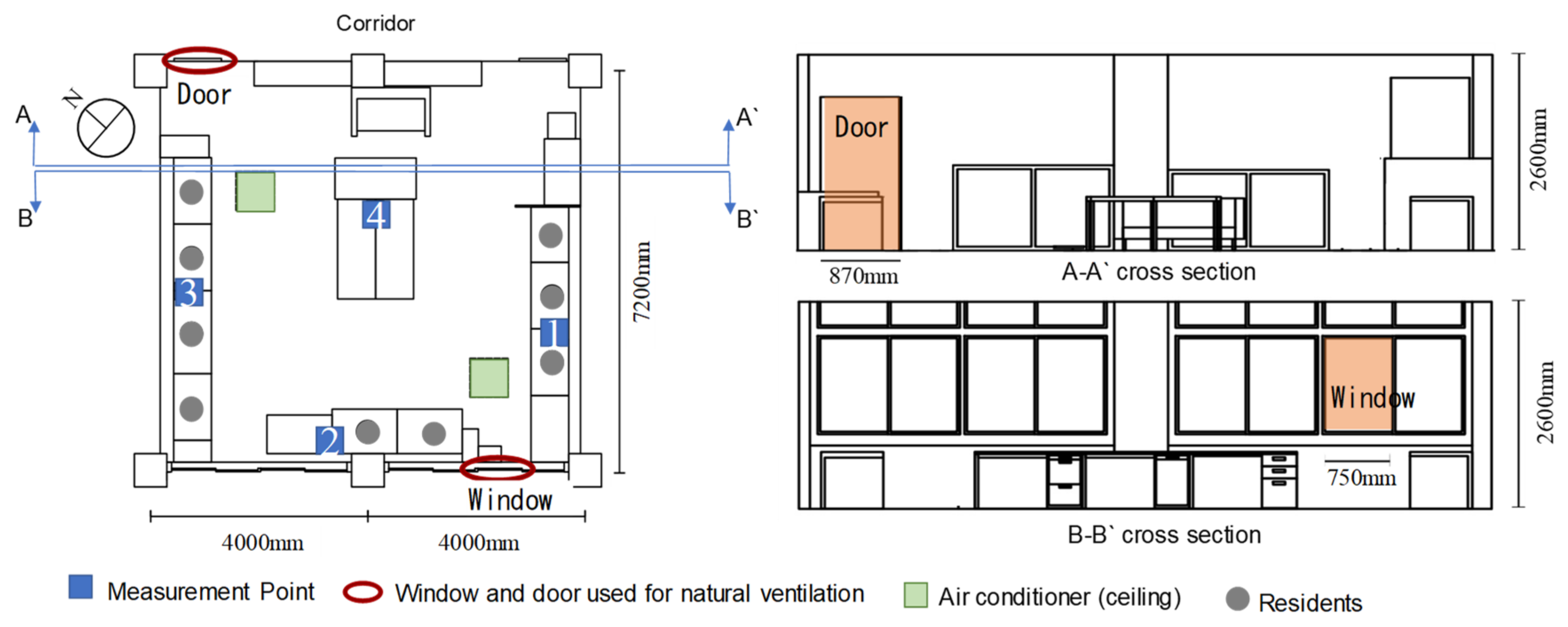
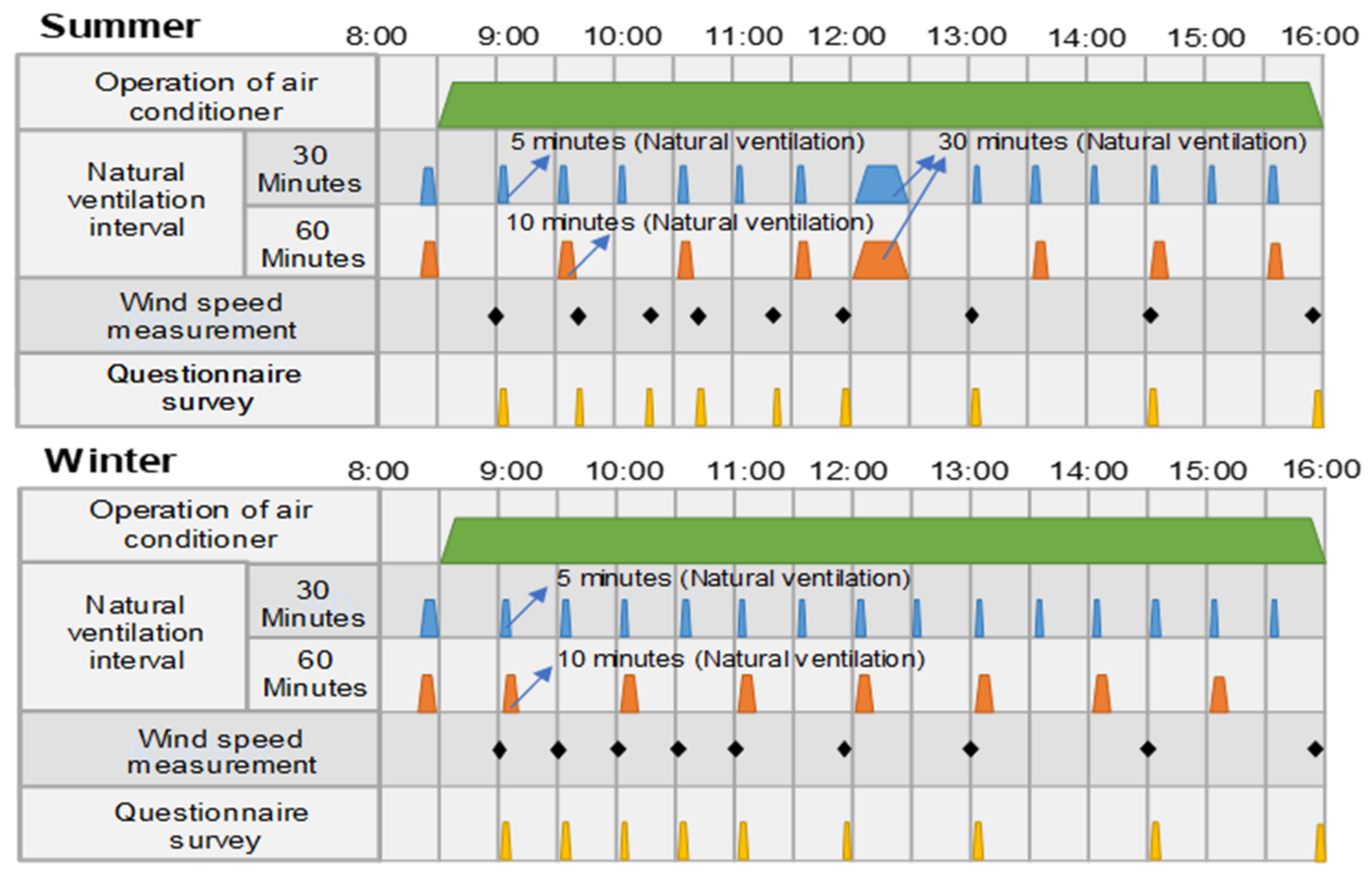
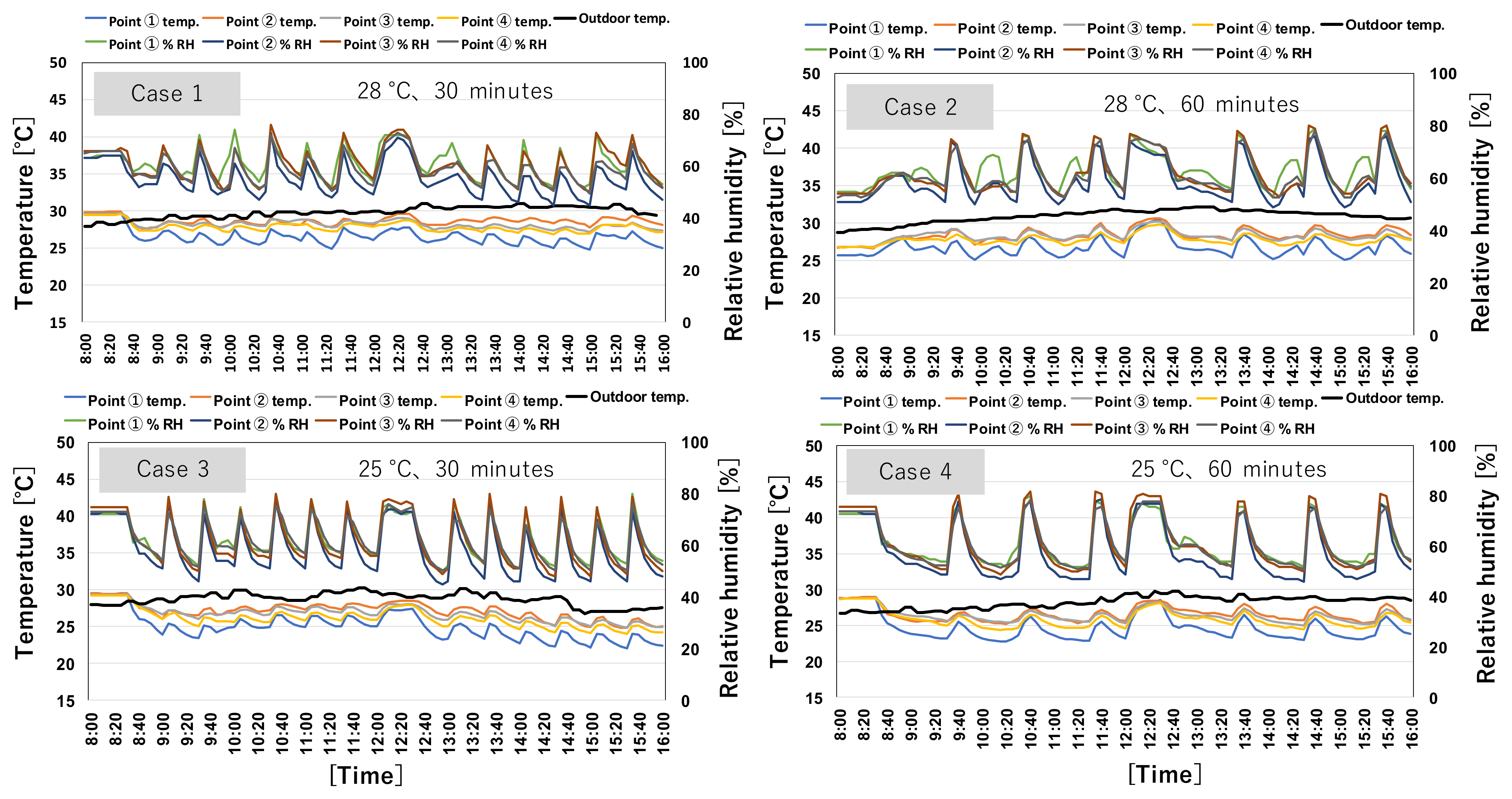
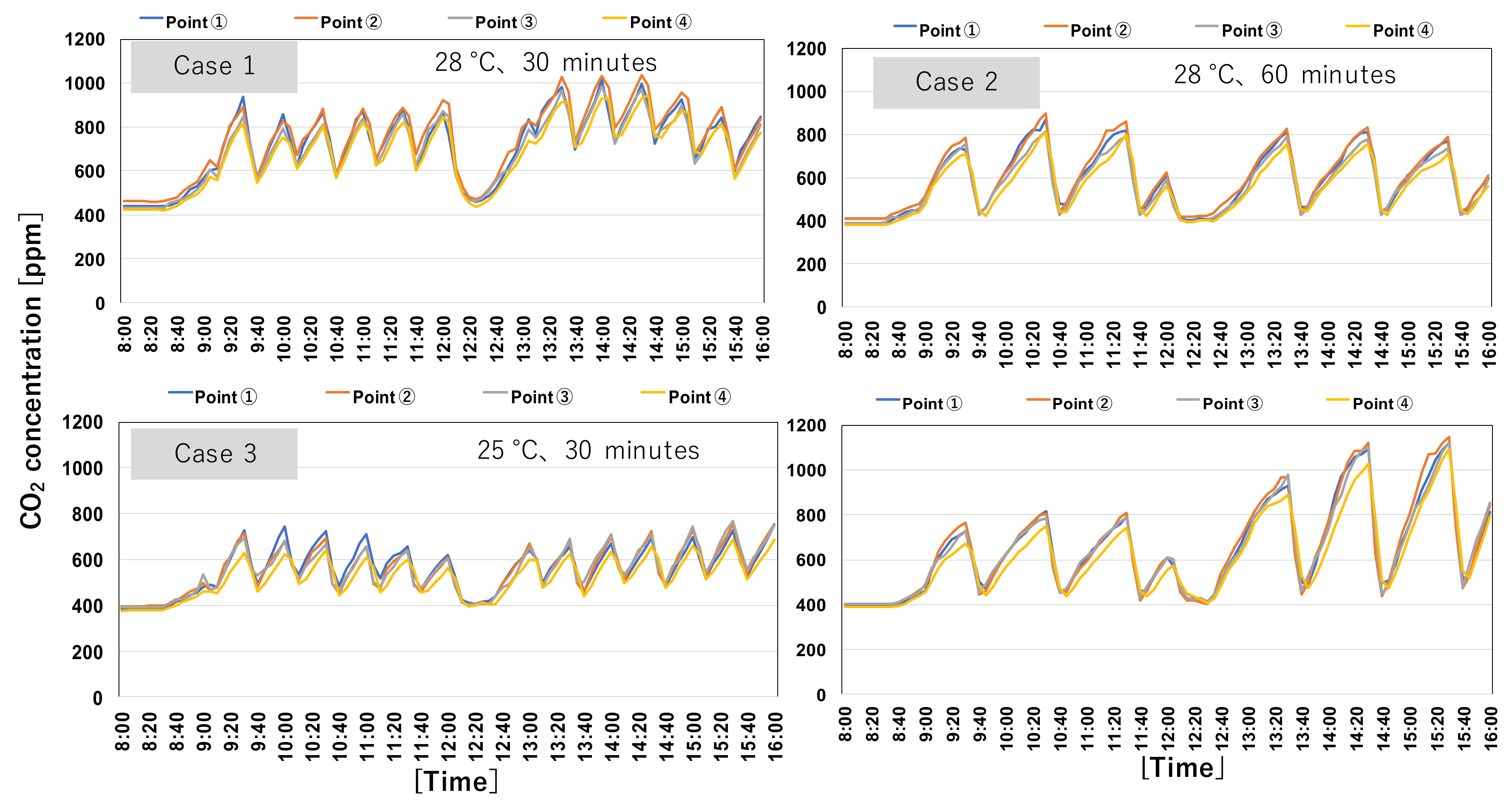
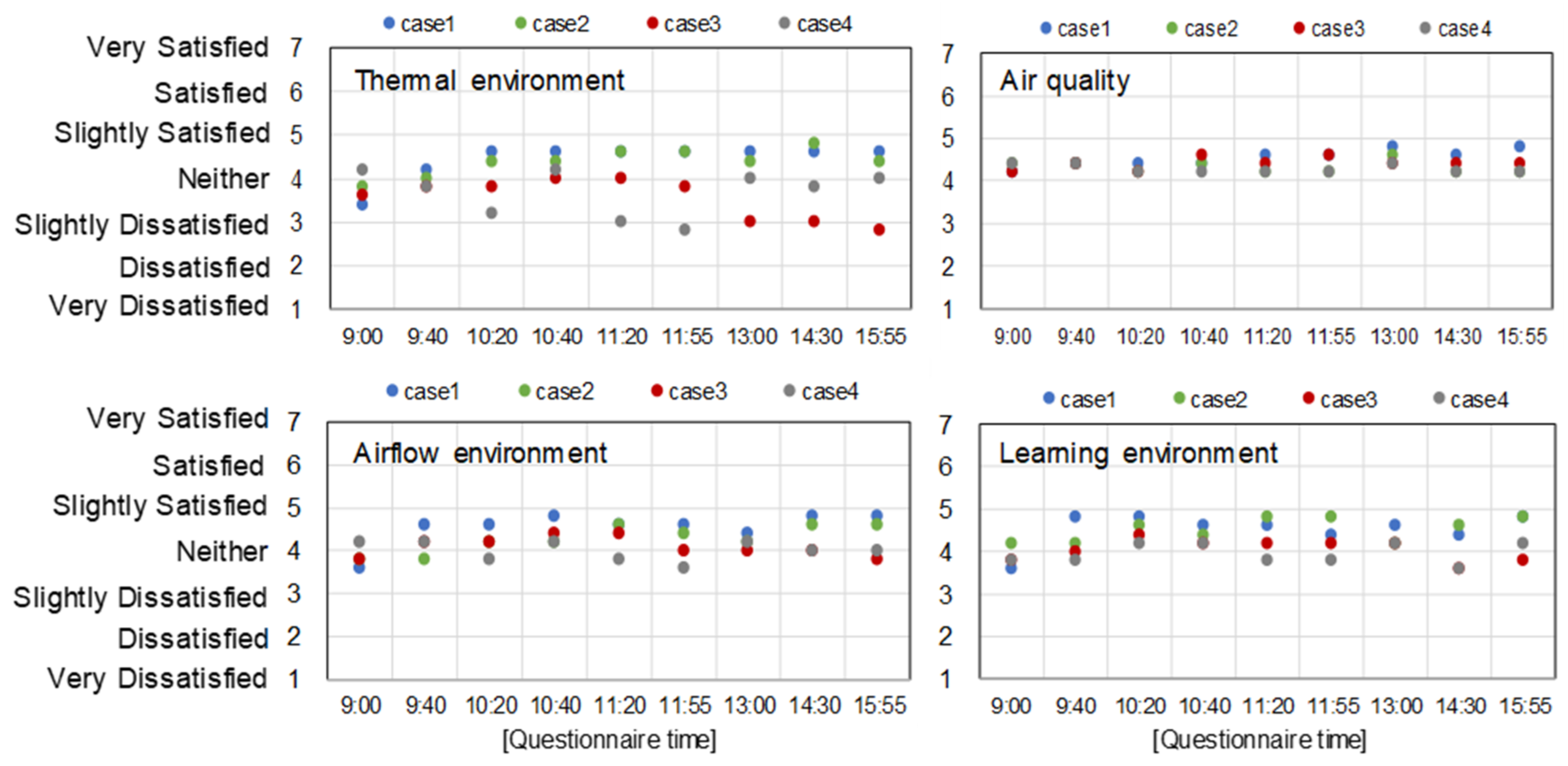

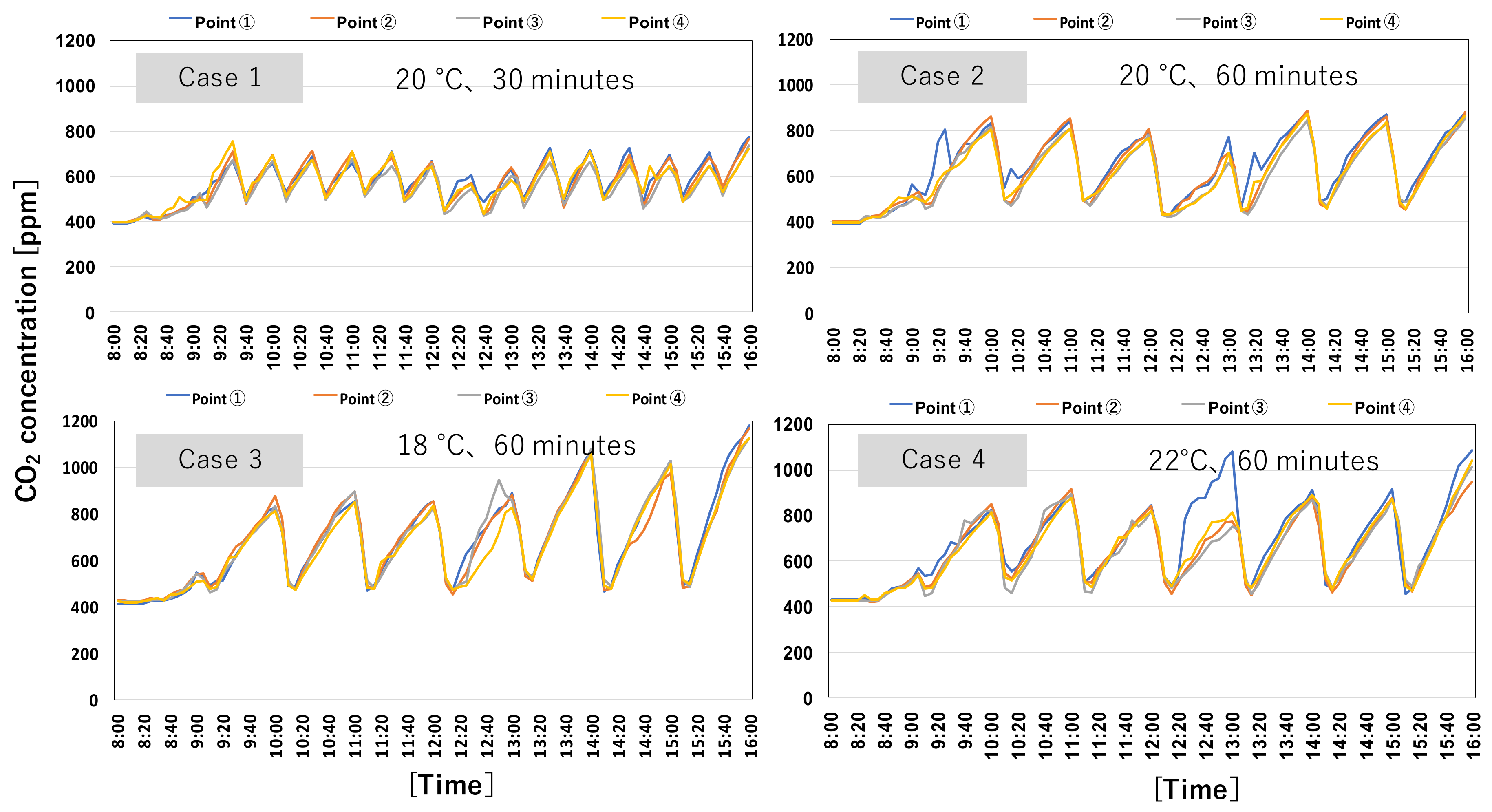


| Measured Data | Measuring Equipment |
|---|---|
| Temperature Relative humidity Radiation temperature | T&D, Wireless Thermo Recorder RTR-322 ESPEC MIC Corp. RTW-30S + Black bulb ϕ40 mm |
| CO2 | T&D, CO2 Recorder TR-76Ui |
| Wind speed | KANOMAX, Anemomaster Model 6035 |
| Measurement Season | Summer | Winter | ||||||
|---|---|---|---|---|---|---|---|---|
| Item | Case 1 | Case 2 | Case 3 | Case 4 | Case 5 | Case 6 | Case 7 | Case 8 |
| Nautral Ventilation interval [min.] | 30 | 60 | 30 | 60 | 30 | 60 | 60 | 60 |
| Air conditioner set temperature [°C] | 28 | 28 | 25 | 25 | 20 | 20 | 18 | 22 |
| Number of people in the room | 9 | |||||||
Publisher’s Note: MDPI stays neutral with regard to jurisdictional claims in published maps and institutional affiliations. |
© 2022 by the authors. Licensee MDPI, Basel, Switzerland. This article is an open access article distributed under the terms and conditions of the Creative Commons Attribution (CC BY) license (https://creativecommons.org/licenses/by/4.0/).
Share and Cite
Kuwahara, R.; Kim, H. Studying the Indoor Environment and Comfort of a University Laboratory: Air-Conditioning Operation and Natural Ventilation Used as a Countermeasure against COVID-19. Buildings 2022, 12, 953. https://doi.org/10.3390/buildings12070953
Kuwahara R, Kim H. Studying the Indoor Environment and Comfort of a University Laboratory: Air-Conditioning Operation and Natural Ventilation Used as a Countermeasure against COVID-19. Buildings. 2022; 12(7):953. https://doi.org/10.3390/buildings12070953
Chicago/Turabian StyleKuwahara, Ryoichi, and Hyuntae Kim. 2022. "Studying the Indoor Environment and Comfort of a University Laboratory: Air-Conditioning Operation and Natural Ventilation Used as a Countermeasure against COVID-19" Buildings 12, no. 7: 953. https://doi.org/10.3390/buildings12070953





